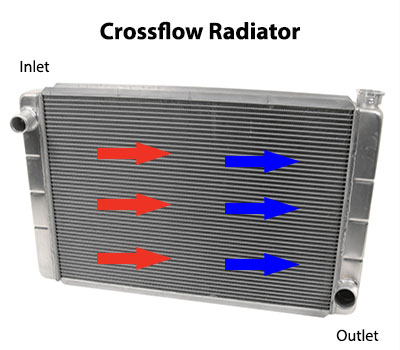
A car’s radiator is one of the most important components of its cooling system. It’s responsible for regulating the temperature of the engine by dissipating heat generated during combustion. Radiators come in different types, and one of the most popular is the cross-flow radiator. In this blog, we will discuss how cross-flow radiators work, their advantages over other radiator types, and why they are important.
How Cross-Flow Radiators Work:
A cross-flow radiator, also known as a horizontal-flow radiator, is designed with the inlet and outlet tanks located on opposite sides. Coolant enters the radiator through the inlet tank and flows through a series of horizontal tubes. As the coolant passes through these tubes, it is cooled by the airflow generated by the engine’s fan. The cooled coolant then exits the radiator through the outlet tank and returns to the engine to repeat the cycle.
Advantages of Cross-Flow Radiators:
- Better Cooling Efficiency: Cross-flow radiators are known to be more efficient than other radiator types. The horizontal tubes allow for better heat dissipation, which leads to improved cooling performance.
- Less Restriction: Since the coolant flows horizontally through the tubes, cross-flow radiators are less restrictive than other types of radiators. This means that they allow for better coolant flow, which can improve the engine’s performance.
- Space-saving Design: Cross-flow radiators have a compact design that saves space in the engine bay. This makes them a popular choice for cars with limited engine bay space.
Why Cross-Flow Radiators Matter:
The cooling system is a critical component of a car’s engine. Without it, the engine would overheat, which can lead to catastrophic failure. Cross-flow radiators play a significant role in keeping the engine cool and running efficiently. They offer better cooling performance, less restriction, and a space-saving design that can benefit many different types of vehicles.
Conclusion:
Cross-flow radiators are an important part of a car’s cooling system. They offer better cooling performance, less restriction, and a space-saving design that can benefit many different types of vehicles. Understanding how they work and their advantages over other radiator types can help you make an informed decision when it comes to selecting the right radiator for your car.
One of the key advantages of cross-flow radiators is their improved cooling efficiency. The horizontal tubes allow for better heat dissipation compared to vertical flow radiators, which have the inlet and outlet tanks located on the same side. This means that cross-flow radiators can more effectively regulate the temperature of the engine and prevent it from overheating.
Additionally, cross-flow radiators are less restrictive than other radiator types. This is because the coolant flows horizontally through the tubes, which allows for better coolant flow and can improve the engine’s performance. This is especially important in high-performance vehicles, where even a small amount of restriction can negatively impact the engine’s power output.
Another benefit of cross-flow radiators is their space-saving design. The horizontal tubes allow for a more compact radiator, which can be particularly useful in vehicles with limited engine bay space. This is why cross-flow radiators are often used in sports cars and other performance vehicles, where space is at a premium.
In terms of maintenance, cross-flow radiators are generally easy to service. The horizontal tubes are easier to clean than vertical tubes, which can become clogged with debris over time. Additionally, cross-flow radiators tend to be more durable than other types of radiators, which means they may require less frequent replacement.
In summary, cross-flow radiators offer several advantages over other radiator types, including improved cooling efficiency, less restriction, and a space-saving design. They are an important component of a car’s cooling system and can help ensure that the engine runs efficiently and reliably.
Advantages:
- Improved Cooling Efficiency: Cross-flow radiators have a horizontal design that allows for better heat dissipation, resulting in improved cooling efficiency. This helps prevent engine overheating and improves the engine’s overall performance.
- Less Restrictive: Because the coolant flows horizontally through the tubes, cross-flow radiators are less restrictive than other radiator types. This allows for better coolant flow and improved engine performance.
- Space-Saving Design: The horizontal design of cross-flow radiators makes them more compact than other radiator types. This is particularly useful in vehicles with limited engine bay space.
- Easy to Service: Cross-flow radiators are generally easy to service, as the horizontal tubes are easier to clean than vertical tubes. They also tend to be more durable than other types of radiators.
Disadvantages:
- More Expensive: Cross-flow radiators are typically more expensive than other types of radiators due to their more complex design and higher manufacturing costs.
- More Prone to Damage: Cross-flow radiators can be more prone to damage than other radiator types due to their horizontal tubes. This can make them more difficult and expensive to repair.
- Lower Capacity: Cross-flow radiators generally have a lower capacity than other radiator types, which can make them less effective in very high-performance applications.
- More Difficult to Install: Installing a cross-flow radiator can be more difficult than installing other types of radiators due to their more complex design and the need for custom mounting brackets in some cases.
Overall, cross-flow radiators offer several advantages over other radiator types, including improved cooling efficiency, less restriction, and a space-saving design. However, they can also be more expensive, prone to damage, and more difficult to install.





